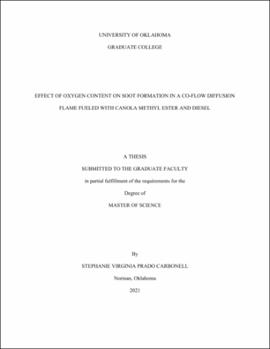| dc.description.abstract | The release of carbon particles (or soot; nanoscale sized carbon spheres) during a combustion process is the sign of hydrocarbon fuel not burning completely. The physical property (nano scaled) and chemical compounds (depending on the fuel) are very harmful for the environment and human health causing respiratory diseases. It is important to study soot formation given the complexity of its growth mechanism. The study of soot formation is one of the most complex phenomena in combustion chemistry. The focus of this study is to enhance the understanding of soot formation in flames formed with oxygen enhanced oxidizer streams. This study is particularly unique because the fuel used is a renewable fuel (biodiesel, BD) and the oxidizer is composed of various oxygen contents. To the knowledge of the author, this is the first work that studies the soot formation of BD oxygen enhanced flames. BD is considered a renewable and clean-burning fuel, composed of vegetable oils and animal fats. Also, BD can be used in diesel engines with very little or no modifications due to its similarity to Petro fuel properties and hence has great potential to replace fossil fuels. Most soot formation studies have been performed in flames formed with gaseous fuels such as methane. In this thesis work the soot formation in vaporized coflow diffusion oxygen enriched flames of BD and No. 2 diesel is studied.
To study soot formation, we must analyze soot particles as they are forming at various flame heights. The proper method to obtain particles in this state is to study their formation in lab created flames. Previous works have studied soot particles using engines. It is very difficult to study soot formation with engines given the soot particles cannot be collected during the combustion process but only at the exhaust. Once soot reaches the end of the exhaust pipe it is different from that formed inside the piston chamber. In this study co-flow diffusion flames are used to obtain the morphological evolution of soot and to obtain primary particle diameter (dp) measurements. In this study the thermophoretic sampling technique is used to capture soot particle samples along the axial direction of the flame. That is, the thermophoretic sampler was inserted inside the flame from regions near the burner mouth to the flame tip. This sampling procedure consists of the insertion of a transmission electron microscopy (TEM) grid inside the luminous zone. Thermophoretic sampling is performed at several heights above burner (HAB) in the axial direction. Soot particles are collected at different HAB to understand the process of soot formation which consists of inception, surface growth, agglomeration, and oxidation. More specifically the BD used in the present study is canola methyl ester (CME) (Milligan Bio-TECH Inc.). The oxygen content is increased in the oxidizer stream from 21% (air), 35%, 50%, and 80%. Soot formation was studied in flames composed of CME and ultra-low sulfur diesel (ULSD) No. 2 obtained locally (Conoco gas station on 3300 W Main St, Norman, OK): CME/21% O2 (air), CME/35% O2, CME/50% O2, CME/80% O2, diesel/21% O2 (air), diesel/35% O2, diesel/50% O2, and diesel/80% O2.
TEM analysis was performed on samples of soot particles captured in the studied flames to obtain soot evolution profiles. This analysis provided low and medium resolution TEM images. To quantitively study soot formation, dp measurements were obtained at several HAB in the axial direction of the flame. To study the effect that oxygen content has on soot formation we must have a basis for comparison. In this study the CME/21% O2 (air) and diesel/21% O2 (air) flames were used as a basis for comparison. To study the effect BD has on soot formation under oxy/fuel conditions we use the diesel oxy/fuel flames as a basis for comparison.
The effect of oxygen content increase on soot formation in CME and No. 2 diesel lead to several observations. Overall, as the oxygen content increased in the oxidizer stream the flame height decreased and the rate of soot formation increased. Also, non-representative short aggregates were found near the burner mouth for both diesel and CME oxygen enriched air flames. Regardless of the fuel or oxygen content used, the stages of soot formation remained the same for all flames tested. The presence of soot precursors was more evident in diesel flames than in CME flames. In the CME flames, “irregular-shaped” structures or “globules” were found. The presence of “globules” decrease as the oxygen content was increased in the oxidizer stream of CME flames. Furthermore, light contrast precursor particles were found in the diesel/50% O2 flame and in all the CME flames. The quantitative study of soot formation via the measurement of dp, revealed that the largest dp value or peak dp values were higher for diesel flames than CME flames. Diesel/35% O2 shows the highest peak dp value ~42.9 nm compared to diesel/air with ~38.5 nm, diesel/50% O2 with ~36.8 nm, and diesel/80% O2 with ~17.3 nm. Examining the trend in CME flames of peak dp vs. oxygen content gives interesting results. The peak dp values are as follows: CME/21% O2 is ~28 nm; CME/35% O2 is ~28.6 nm; and CME/50% O2 is ~24 nm. Since the dp value decrease is more notable for oxygen-enhanced flames in CME we can see the oxidation process is accelerated. | en_US |

